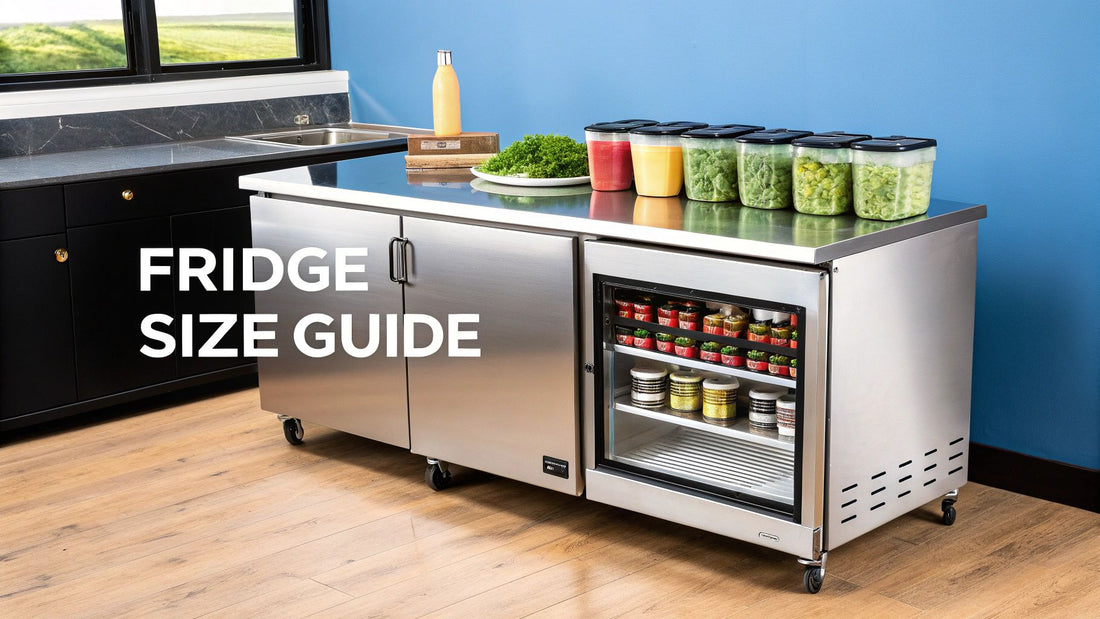
Find the Perfect Under Counter Fridge Size for Your Pizza Prep Table
Share
Choosing the right under counter fridge size is about more than just measurements; it's the secret ingredient to a fast, efficient pizza prep line. A perfectly sized unit is the engine of your kitchen's production, streamlining workflow and cutting down on the chaos during that dinner rush. Nail this from the start, and you'll prevent bottlenecks and set your team up for success.
Matching Your Fridge Size to Your Pizzeria's Needs
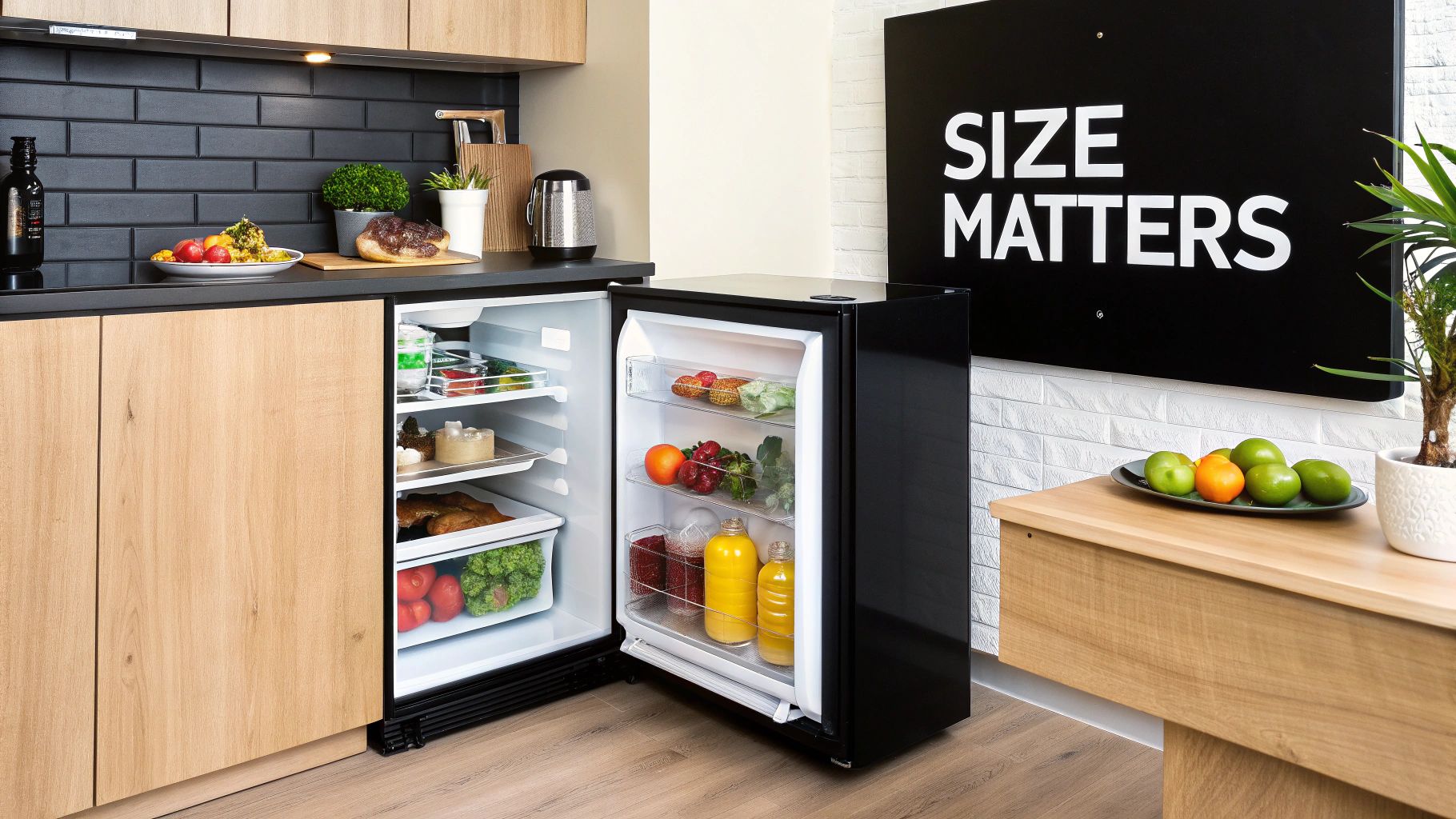
In the world of pizza making, every single second counts. An under counter fridge isn’t just a cold box—it's an active workstation. Think of it as the pit stop in a Formula 1 race; the faster your pizza maker can grab cheese, pepperoni, and sauce, the quicker that pie hits the oven.
Get the under counter fridge size wrong, and you've thrown a wrench in the entire process.
A unit that’s too small will have your crew making constant trips to the walk-in cooler, creating painful delays and killing the flow of your prep line. On the flip side, a fridge that's too big eats up valuable floor space, creating a cramped, awkward work environment that just slows everyone down.
Building an Ergonomic Pizza Prep Station
The goal is to create a seamless, ergonomic triangle between your dough station, the topping ingredients, and the oven. Your under counter fridge is the heart of this entire setup. The right dimensions ensure it slides perfectly beneath your pizza prep table, keeping every essential ingredient within arm's reach.
This tight integration is a game-changer for a few key reasons:
- Speed and Efficiency: It eliminates wasted steps, letting your staff build pizzas faster.
- Reduced Staff Fatigue: A smart workspace reduces the physical strain on your team, which leads to better morale and higher productivity.
- Consistent Quality: When fresh, properly chilled ingredients are easy to access, every single pizza meets your high standards.
The connection between your fridge dimensions and pizza prep workflow is direct and powerful. The right unit doesn't just store ingredients; it actively speeds up service and enhances your team's performance during peak hours.
Ultimately, selecting the correct under counter fridge size is a strategic move that affects your entire operation. It’s a foundational piece in a much larger system of commercial food prep equipment all designed for maximum output. When you're planning your pizzeria's layout, a solid ultimate kitchen remodel checklist can be an invaluable guide to make sure every detail, including appliance integration, is covered.
Standard Under Counter Fridge Dimensions Explained
Trying to figure out commercial refrigeration for a pizzeria can feel like you're solving a complex puzzle. But here’s the good news: the standard under counter fridge size exists for one simple reason—to slot perfectly into your pizza prep line. These dimensions aren't random; they’re the result of decades of kitchen design focused on pure efficiency, especially in a fast-paced spot like a pizzeria.
The most common sizes are built to slide right under a standard-height pizza prep table. From what we've seen in the industry, these undercounter workhorses are growing in popularity because they just make sense for maximizing your floor space and keeping ingredients close.
Most units will be about 24 inches in width, 34 to 35 inches in height, and somewhere between 24 to 28 inches in depth. These very specific measurements allow them to fit seamlessly under pizza prep tables while still offering a surprising amount of storage. For a deeper dive into the commercial refrigeration market, check out the analysis from Future Market Insights.
Common Widths for Pizza Prep Lines
While height and depth are pretty consistent across the board, width is where you’ll find the most variety. The width you pick has a direct impact on how many toppings and ingredients you can keep on the line.
This chart breaks down the market share for three of the most popular under-counter fridge widths out there.
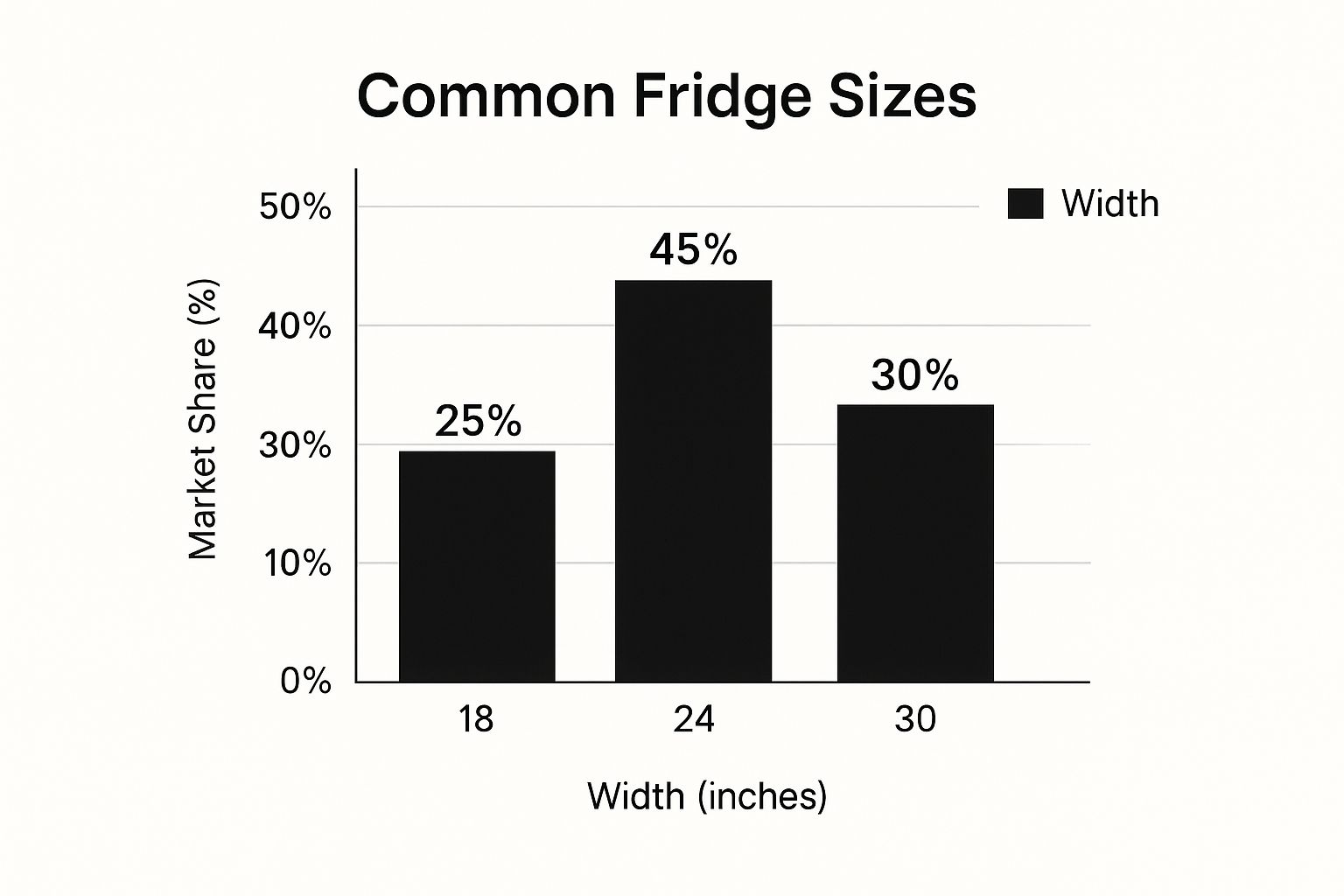
As you can see, the 24-inch model is a popular base size. It’s the versatile, do-it-all option that works in a ton of different pizzeria layouts, often as a secondary unit.
Choosing the right width is like picking the right size toolbox for the job. A 24-inch unit is a reliable standard, while wider models are for high-volume specialists who need every topping within immediate reach.
Typical Under Counter Fridge Sizes for Pizza Prep Lines
A quick way to eyeball a fridge’s width and capacity is just to count the doors. For a pizza line, this tells you exactly how much cheese, sauce, and pepperoni you can store before someone has to make a run to the walk-in.
To help you visualize what might work for your shop, I've put together a table breaking down the typical sizes you'll find for single, double, and triple-door models used in pizza restaurants.
| Fridge Type | Typical Width (Inches) | Typical Capacity (Cu. Ft.) | Best For |
|---|---|---|---|
| Single-Door | 27" – 36" | 6 – 9 | Small pizzerias, cafes, or secondary prep stations. |
| Double-Door | 48" – 60" | 12 – 18 | Medium-volume pizzerias with a diverse topping menu. |
| Triple-Door | 72" – 93" | 19 – 28+ | High-volume operations needing maximum ingredient access. |
Ultimately, getting a handle on these standard dimensions is the first step toward building a prep station that works for you, not against you. When you match the under counter fridge size to your pizzeria's real-world volume, you're setting your team up to crush the dinner rush without breaking a sweat.
How Fridge Size Impacts Your Pizza Prep Line Workflow
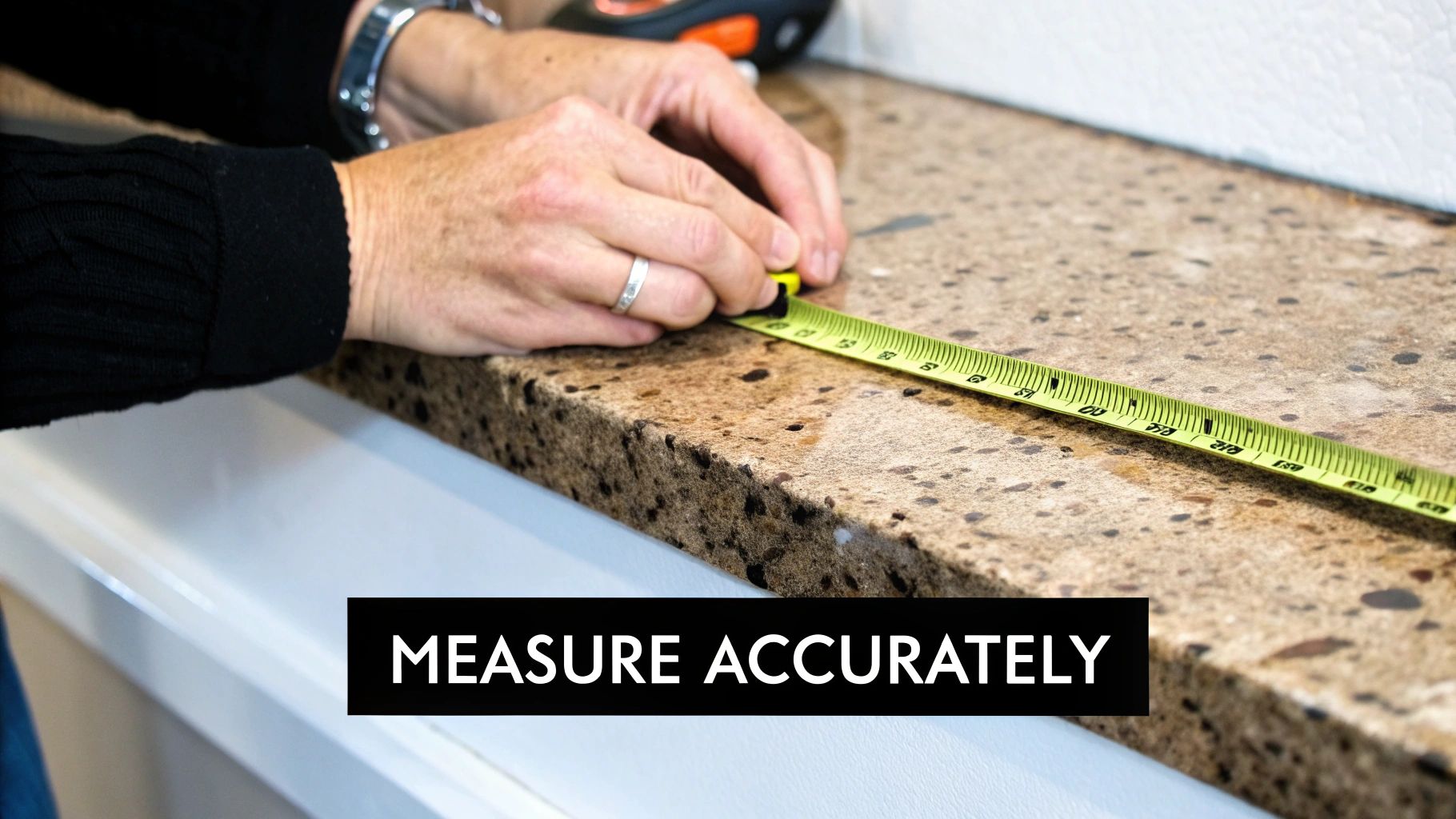
In a bustling pizzeria, your under-counter fridge is so much more than just a cold box—it's the engine driving your entire prep line. Get the under counter fridge size right, and it becomes a performance-enhancing tool that dictates the speed, efficiency, and even the comfort of your pizza makers.
Think of it as a seamless extension of your pizza maker's workspace. When it's sized correctly, every essential ingredient, from shredded mozzarella to sliced pepperoni, is perfectly chilled and just inches away. This setup kills wasted motion, reduces physical strain on your crew, and shaves precious seconds off every single order. It’s the secret to a smooth kitchen rhythm.
The Cost of an Incorrect Fridge Size
Getting the dimensions wrong can sabotage your pizza workflow in two very different ways, but both lead to the same result: slower service and a frustrated staff. An improperly sized unit creates instant bottlenecks that are almost impossible to fix without swapping out the equipment.
A fridge that’s too small is a guaranteed recipe for chaos during a dinner rush. Its limited capacity forces your team into a painful cycle of constant restocking. Imagine your best pizza maker running out of cheese mid-service. That frantic trip to the walk-in cooler doesn’t just delay one order—it creates a domino effect, disrupting the flow for every ticket after it.
On the flip side, a unit that’s too large can be just as damaging. An oversized fridge devours valuable floor space, creating a cramped and clumsy layout. It can block walkways and force awkward movements, completely disrupting the natural dance between the prep station, oven, and finishing area. This kind of poor ergonomic design leads directly to staff fatigue and a higher risk of accidents.
Getting the under counter fridge size right is a direct investment in your pizzeria's productivity. It's the difference between a prep line that flows smoothly and one that constantly fights against itself, creating friction with every pizza made.
A Real-World Pizzeria Scenario
Let's paint a picture of an efficient pizzeria in action. The pizza maker stands at a 72-inch pizza prep table with a perfectly integrated triple-door under-counter fridge right below.
- Door 1: Holds dough trays, proofed and ready to go.
- Door 2: Stores high-volume cheeses and signature sauces.
- Door 3: Contains all the prepped toppings, from veggies to meats.
In this setup, the chef can build an entire pizza with almost no wasted movement—just a simple pivot and an easy reach. There are no extra steps, no time spent searching for ingredients, and no reason to leave the station. This is exactly how the right equipment translates directly into faster ticket times and a team that can handle the busiest nights without breaking a sweat. The correct under counter fridge size isn't just a detail; it's a core ingredient for a profitable pizzeria.
Integrating Your Fridge with Pizza Prep Tables and Topping Rails
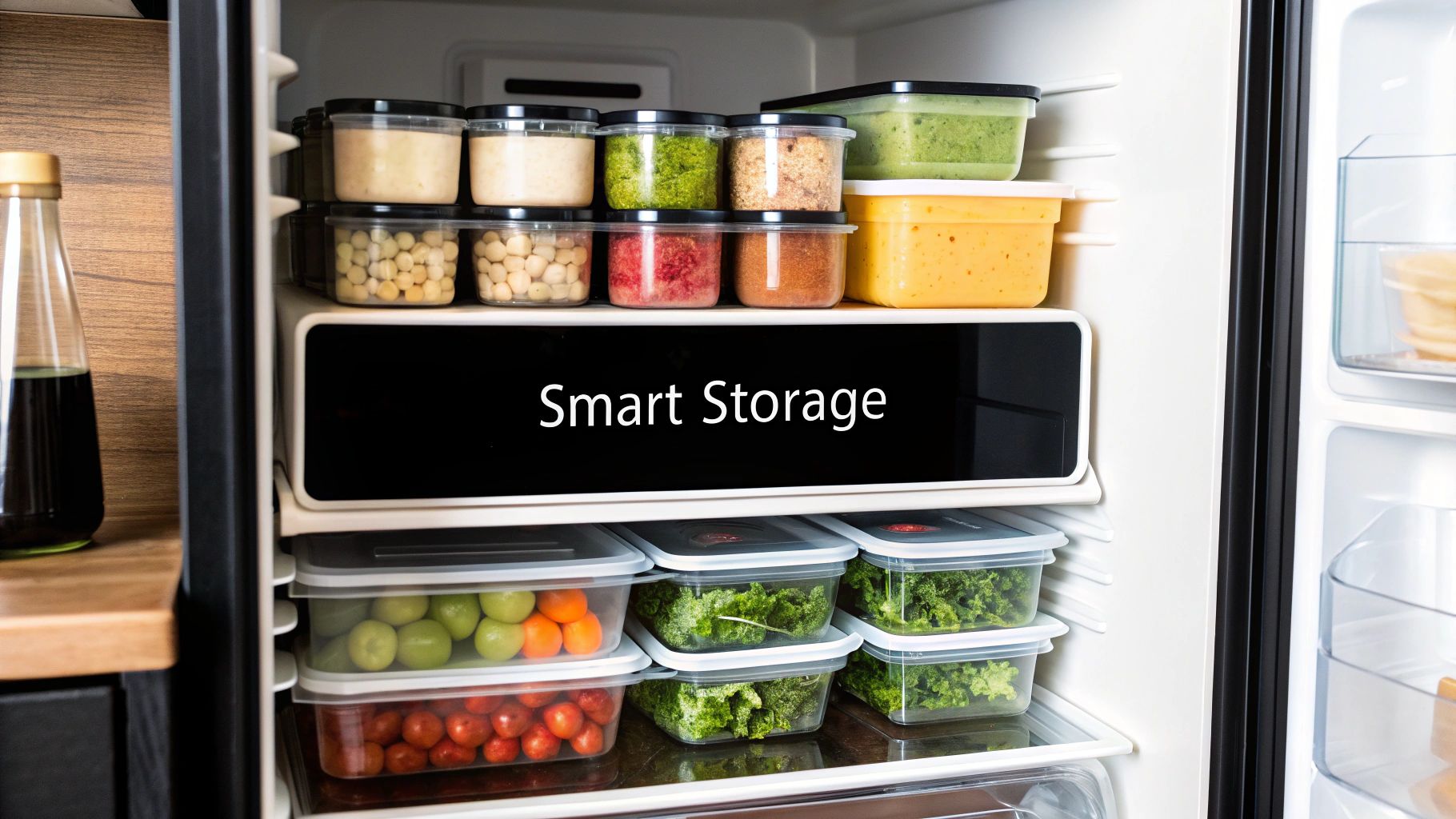
The perfect pizza prep station isn’t just a collection of equipment; it’s a single, unified workspace where everything fits together seamlessly. This starts with making sure your under counter fridge size lines up perfectly with your pizza prep tables and topping rails. It’s less about just making it fit and more about creating an efficient and sanitary command center for pizza making.
The real goal here is to have the refrigerator slide in perfectly flush with the pizza prep counter sitting above it. When you get this right, you eliminate those annoying gaps where cheese, flour, and sauce inevitably end up. This simple detail makes cleanup a breeze and keeps your kitchen up to health code standards. For a closer look at building out your entire workstation, our guide on the commercial pizza prep table is a great place to start.
Matching Height for a Flush Work Surface
First things first, let's talk height. A standard commercial pizza prep table is about 36 inches tall. Manufacturers know this, so most under-counter refrigerators are designed to be around 34 inches high. That little bit of wiggle room is intentional—it leaves just enough space for leveling the unit and sliding it in without a fight.
Getting that flush fit is non-negotiable. When the top of the fridge meets the bottom of the prep table without a gap, you create a clean, unbroken surface. This prevents spills from dripping down the back and makes the end-of-night wipe-down quick and painless.
The global market for these fridges is valued at around USD 4.5 billion, which tells you just how critical they are in modern kitchens. That massive market depends on standardized dimensions to allow for the kind of flawless integration pizzerias need to be successful.
An ideal under counter fridge doesn't just fit—it merges with your pizza prep table. This synergy is what turns separate pieces of steel into a powerful, efficient prep line built for speed and cleanliness.
Why Ventilation Is a Non-Negotiable Detail
Beyond just sliding into place, your refrigerator needs to breathe. This is easily the most overlooked—and most critical—part of the installation. Without proper airflow, the compressor has to work overtime. You'll see it in your energy bills, you'll see it when components fail, and you'll definitely see it when your cooling becomes inconsistent, putting your pizza ingredients at risk.
This is where understanding the different types of ventilation becomes absolutely essential:
- Front-Breathing Units: These are the gold standard for any built-in pizza prep line. They pull air in and push it out through a grille right on the front of the unit. This means you can install them with zero clearance on the back and sides, maximizing your precious kitchen space.
- Rear-Breathing Units: These models are designed to have open space around them. They need a few inches of clearance at the back and on the sides to circulate air properly. If you shove one of these into a tight enclosure under your prep table, you're just asking for it to overheat and die an early death.
For any pizzeria, choosing a front-breathing model is the smartest move you can make. It lets you build a tight, efficient line without compromising the health or lifespan of your equipment. It's a small detail that pays off big time, service after service.
It’s What’s on the Inside That Counts: Features Beyond Fridge Size
Nailing the right under counter fridge size is a huge first step, but the features packed inside are what really separate a decent piece of equipment from a true pizza prep workhorse. For a busy pizzeria where every second is money, modern tech and smart design aren't just nice-to-haves; they're non-negotiable. They’re what turn a simple cold box into a high-performance tool on your prep line.
The absolute foundation of any quality commercial fridge is its bones. In a high-mess, high-traffic pizza kitchen, durable stainless-steel construction is the only way to go. It’s built to survive the daily grind, shrugs off corrosion from acidic stuff like tomato sauce, and makes the end-of-night cleanup way faster.
Technology That Protects Your Profits
Beyond the steel, it’s the tech inside that guards your pizza ingredients and keeps things running like clockwork. Forget about those old-school analog dials—today's commercial units are loaded with features built for precision and efficiency.
Here are the key things to look for:
- Digital Temperature Controls: These give you exact, easy-to-read temperature management. You know for a fact that your cheese, meats, and dough are held at the perfect food-safe temperature, which is critical for both consistency and passing health inspections.
- Energy-Efficient Compressors: Modern compressors are smarter, using way less electricity to stay cold. This translates directly to lower utility bills over the life of the fridge—a simple way to cut overhead without sacrificing an ounce of performance.
- Self-Closing Doors: Think about how many times that fridge door gets opened during a dinner rush. Self-closing doors are a brilliantly simple feature that guarantees the door always shuts tight, preventing cold air from escaping and protecting your ingredients from dangerous temperature swings. For a closer look at specific models, our breakdown of the under counter glass door refrigerator has some great insights.
In a pizzeria, your under counter fridge isn't just storage; it's an insurance policy. Features like digital controls and self-closing doors actively protect your food inventory from spoilage, saving you real money and preventing service meltdowns.
These kinds of tech upgrades, from digital controls to eco-friendly refrigerants, have become standard selling points. The industry is even moving toward smart refrigeration that connects to the internet, allowing for remote temperature monitoring and even predicting when you'll need maintenance. According to some great reporting on commercial refrigeration trends on futuremarketinsights.com, these innovations are helping pizzerias meet tough food safety rules while saving on energy.
Think about it—a smart feature that alerts your phone to a temperature drop can prevent thousands of dollars in spoiled cheese and pepperoni before it becomes a full-blown crisis. That makes it an essential part of any modern pizzeria.
Still Have Questions About Under Counter Fridges?
Picking the right under counter fridge usually brings up a few last-minute questions. I get it. This is a big purchase, and you want to be confident it will support your pizzeria’s workflow for years. Let's tackle some of the most common things that come up when pizzeria owners are planning their prep line.
Getting these final details right is what separates a good pizza prep line from a great one.
How Much Clearance Does an Under Counter Fridge Need?
This is a critical one, and getting it wrong can kill your compressor. The amount of space you need all comes down to how the unit breathes.
Front-breathing models are the heroes of tight pizza prep lines. They’re built to pull in air and push it out through a grille on the front, which means they need almost zero clearance on the sides or back. You can slide them right into a cabinet run or snug them up against other equipment without a second thought.
Rear-breathing models are a completely different beast. These guys need room to breathe, typically at least 2-3 inches of open space behind and on the sides for air to circulate. Boxing one of these in under a pizza prep table is a surefire way to get sky-high energy bills and a dead compressor. Always, always check the manufacturer’s spec sheet before you install anything.
What Is the Best Fridge Size for a Small Pizzeria?
For a smaller spot or even a secondary prep station, a single-door or two-drawer under counter model is usually the perfect fit. A standard 27-inch wide unit gives you around 6-7 cubic feet of storage, which is plenty for holding prepped ingredients to get you through a steady service.
The name of the game is balancing the fridge's footprint with its holding capacity. I'm a big fan of two-drawer models for small spaces—they offer a huge organizational advantage. You can keep cheeses in one drawer and meats in another, keeping your line tidy and cutting down on those time-wasting trips to the walk-in.
For a small pizzeria, the right under counter fridge size isn't about maximum capacity—it's about maximum efficiency in a compact space. The best unit keeps everything within arm's reach without overcrowding your kitchen.
Can I Use a Residential Fridge Under My Pizza Prep Table?
Let me be direct: absolutely not. You must use a commercial-grade refrigerator in a professional pizzeria. It's not just a suggestion; it's a hard rule for safety and performance.
Residential units just aren't built for the heat and abuse of a pizza kitchen. Here's why they fail:
- Weak Compressors: Commercial units have powerful cooling systems designed to bounce back to a safe temperature after the door has been opened dozens of times an hour during a dinner rush. A home fridge can't keep up.
- Flimsy Construction: Commercial fridges are made with stainless steel for a reason. It stands up to the chaos of a busy line and harsh cleaning chemicals that would destroy a residential unit.
- Health Code Violations: Commercial refrigerators are NSF-certified. This isn't optional; it's a requirement to meet health codes for food safety.
On top of that, their standard height of around 34-35 inches is made to slide perfectly under commercial pizza prep tables. Using a residential fridge is a guaranteed health code violation and a fast track to equipment failure.
How Do I Calculate the Fridge Capacity I Need for My Pizzeria?
Figuring out the capacity you need isn't as complicated as it sounds. Start by thinking about your busiest service. First, make a list of every refrigerated ingredient you need at the prep station—cheese, sauce, dough, and every single topping. Then, estimate how much of each you need to get through a 2-3 hour rush without running back to the walk-in.
A great trick is to visualize your ingredients in standard food pan sizes, like 1/6 or 1/3 pans. This helps turn your shopping list into a real-world volume that you can match to a fridge's capacity.
As a quick guide for choosing an under counter fridge size:
- A 27-inch unit (6-7 cu. ft.) is great for low-volume pizzerias or secondary stations.
- A 48-inch unit (12-13 cu. ft.) hits the sweet spot for most medium-volume pizzerias.
- A 60-inch or larger unit (16+ cu. ft.) is a must for high-volume pizza operations.
My advice? Always overestimate your needs just a little. It's much cheaper than having to buy a second unit a year down the road when your business takes off.
Ready to build the perfect prep line for your pizzeria? Pizza Prep Table offers a wide selection of commercial under-counter refrigerators designed to fit seamlessly into any kitchen workflow. Find the ideal size and features to boost your efficiency.
